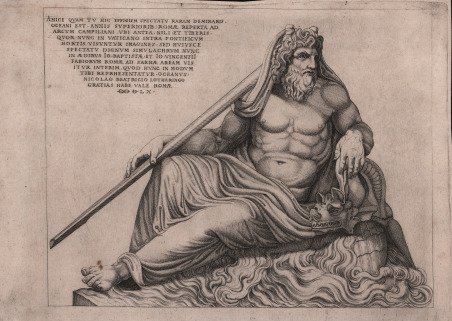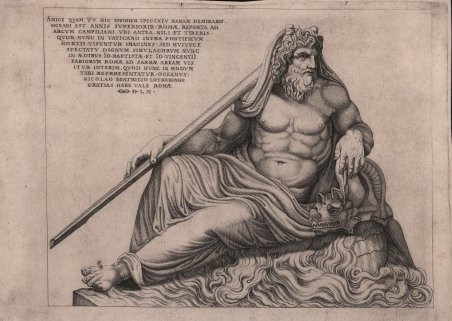Bulino, 1560, firmato e datato in lastra in alto al centro. Esemplare nel terzo stato di quattro, con la parola Amice all'inizio dell'iscrizione e l'indirizzo di Claudio Duchetti: «AMICE QVAM TV HIC EFFIGIEM SPECTATV RARAM DEMIRARIS OCEANI EST ANNIS SVPERIORIB[VS] ROMÆ REPERTA AD ARCVM CAMPILIANI VBI ANTEA NILI ET TIBERIS QVOR[RVM] NVNC IN VATICANO INTRA PONTIFICVM HORTIS VISVNTVR IMAGINES SED HVIVSCE SPECTATV DIGNVM SIMVLACHRVM NVNC IN ÆDIBVS IO[ANNIS] BAPTISTAE ET IO[ANNIS] VINCENTII FABIORVM ROMÆ AD SARRÆ AREAM VISITVR INTERIM QVOD HVNC IN MODVM TIBI REPRHESENTATVR OCEANVS NICOLAO BRATRICIO LOTHARINGO GRATIAS HABE VALE ROMÆ ? D LX» [Amico, l’immagine che tu rimiri, rara a vedersi, è l’immagine di Oceano. Fu ritrovata anni addietro presso l’arco di Campiliano dove ancor prima [erano state trovate] le immagini del Nilo e del Tevere che ora si possono visitare in Vaticano, negli orti pontifici. Ma questa statua, degna di essere veduta, si visita per ora nel palazzo di Giovanni Battista e Giovanni Vincenzo Fabii, a Roma, presso l’area di Sarra. Per te l’Oceano è raffigurato in questo modo da Nicolas Beatrizet, lorenense. Grazie, e sta bene. Roma 1560].La statua era compresa nel lotto di sculture che i Farnese acquistarono dalla Collezione di Bernardino Fabio tra il 1547 ed il 1549. I Fabii, possessori di Castel Fusano, di parte dello stagno di Ostia e di altre tenute, avevano raccolto parecchie sculture di grande pregio fra le quali la statua di Oceano qui raffigurata.A Palazzo Farnese la statua rimase sino al 1786 per essere poi trasportata via mare a Napoli nel 1789, insieme a tutta la Collezione farnesiana e oggi è al Museo Archeologico Nazionale della stessa città. L’opera viene datata (anche se non concordemente dagli studiosi) al II secolo d.C. Il dio Oceano giace sdraiato su un fianco sopra una superficie increspata che simboleggia il mare. Sulle sue spalle poggia un remo mentre un braccio è posto quasi ad accarezzare un Ketos, o drago marino. ' Magnifica prova, impressa su carta vergata coeva con filigrana "losanga nel cerchio con stella" (cfr. Woodward n. 288), con sottili margini, in ottimo stato di conservazione.L’opera appartiene allo ' Speculum Romanae Magnificentiae, la prima iconografia della Roma antica. ' L'opera figura nell'Indice Lafrery, al n. 171, come “Simulacro di Oceano nella casa di Gioanbattista & Gioanuincenzo de Fabij alla piazza di Sciarra”. Lo ' Speculum ' ebbe origine nelle attività editoriali di Antonio Salamanca e Antonio Lafreri (Lafrery). Durante la loro carriera editoriale romana, i due editori - che hanno lavorato insieme tra il 1553 e il 1563 - hanno avviato la produzione di stampe di architettura, statuaria e vedutistica della città legate alla Roma antica e moderna. Le stampe potevano essere acquistate individualmente da turisti e collezionisti, ma venivano anche acquistate in gruppi più grandi che erano spesso legati insieme in un album. Nel 1573, Lafreri commissionò a questo scopo un frontespizio, dove compare per la prima volta il titolo Speculum Romanae Magnificentiae. Alla morte di Lafreri, due terzi delle lastre di rame esistenti andarono alla famiglia Duchetti (Claudio e Stefano), mentre un altro terzo fu distribuito tra diversi editori. Claudio Duchetti continuò l’attività editoriale, implementando le lastre dello Speculum con copie di quelle “perdute” nella divisione ereditaria, che fece incidere al milanese Amborgio Brambilla. Alla morte di Claudio (1585) le lastre furono cedute – dopo un breve periodo di pubblicazione degli eredi, in particolare nella figura di Giacomo Gherardi - a Giovanni Orlandi, che nel 1614 vendette la sua tipografia al fiammingo Hendrick van Schoel. Stefano Duchetti, al contrario, cedette le proprie matrici all’editore Paolo Graziani, che si associò con Pietro de Nobili; il fondo confluì nella tipografia De Rossi passando per le mani di editori come Marcello Clodio, Claudio Arbotti e Giovan Battista d. Engraving, 1560, signed on plate.Third state of four, with the inscription: «AMICE QVAM TV HIC EFFIGIEM SPECTATV RARAM DEMIRARIS OCEANI EST ANNIS SVPERIORIB[VS] ROMÆ REPERTA AD ARCVM CAMPILIANI VBI ANTEA NILI ET TIBERIS QVOR[RVM] NVNC IN VATICANO INTRA PONTIFICVM HORTIS VISVNTVR IMAGINES SED HVIVSCE SPECTATV DIGNVM SIMVLACHRVM NVNC IN ÆDIBVS IO[ANNIS] BAPTISTAE ET IO[ANNIS] VINCENTII FABIORVM ROMÆ AD SARRÆ AREAM VISITVR INTERIM QVOD HVNC IN MODVM TIBI REPRHESENTATVR OCEANVS NICOLAO BRATRICIO LOTHARINGO GRATIAS HABE VALE ROMÆ ? D LX», and with the imprint of Claudio Duchetti.The statue was included in the batch of sculptures that the Farnese family bought from the Bernardino Fabio Collection between 1547 and 1549. The Fabii, owners of Castel Fusano, part of the pond of Ostia and other estates, had collected several sculptures of great value including the statue of Oceano depicted here.At Palazzo Farnese the statue remained until 1786 and was then transported by sea to Naples in 1789, together with the entire Farnese Collection, and today it is in the National Archaeological Museum of the same city. The work is dated (even if scholars do not agree) to the second century AD. The god Ocean lies lying on a side above a rippled surface that symbolizes the sea. An oar rests on his shoulders while an arm is placed almost to caress a Ketos, or sea dragon.The print proposed here is from the first edition by Antonio Lafréry (without editorial imprint) engraved by Nicolas Beatrizet in 1560. A third edition bears the name of Duchetti, while the fourth edition was made by Giovanni Orlandi (1602).The work appears in the Lafreri Index, at no. 171, as "Simulacro di Oceano nella casa di Gioanbattista & Gioanuincenzo de Fabij alla piazza di Sciarra”.Magnificent example, printed on contemporary paper with watermark "losenge in a circle with star" (Woodward 288), thin margins, in excellent condition. The work belongs to the Speculum Romanae Magnificentiae, the earliest iconography of ancient Rome. ' The Speculum originated in the publishing activities of Antonio Salamanca and Antonio Lafreri (Lafrery). During their Roman publishing careers, the two editors-who worked together between 1553 and 1563-started the production of prints of architecture, statuary, and city views related to ancient and modern Rome. The prints could be purchased individually by tourists and collectors, but they were also purchased in larger groups that were often bound together in an album. In 1573, Lafreri commissioned a frontispiece for this purpose, where the title Speculum Romanae Magnificentiae appears for the first time. Upon Lafreri's death, two-thirds of the existing copperplates went to the Duchetti family (Claudio and Stefano), while another third was distributed among several publishers. Claudio Duchetti continued the publishing activity, implementing the Speculum plates with copies of those "lost" in the hereditary division, which he had engraved by the Milanese Amborgio Brambilla. Upon Claudio's death (1585) the plates were sold - after a brief period of publication by the heirs, particularly in the figure of Giacomo Gherardi - to Giovanni Orlandi, who in 1614 sold his printing house to the Flemish publisher Hendrick van Schoel. Stefano Duchetti, on the other hand, sold his own plates to the publisher Paolo Graziani, who partnered with Pietro de Nobili; the stock flowed into the De Rossi typography passing through the hands of publishers such as Marcello Clodio, Claudio Arbotti and Giovan Battista de Cavalleris. The remaining third of plates in the Lafreri division was divided and split among different publishers, some of them French: curious to see how some plates were reprinted in Paris by Francois Jollain in the mid-17th century. Different way had some plates printed by Antonio Salamanca in his early period; through his son Francesco, they goes to Nicolas van Aelst's. Other editors who contributed to the Speculum were the brothers Michel. Cfr.


Scopri come utilizzare
Scopri come utilizzare

